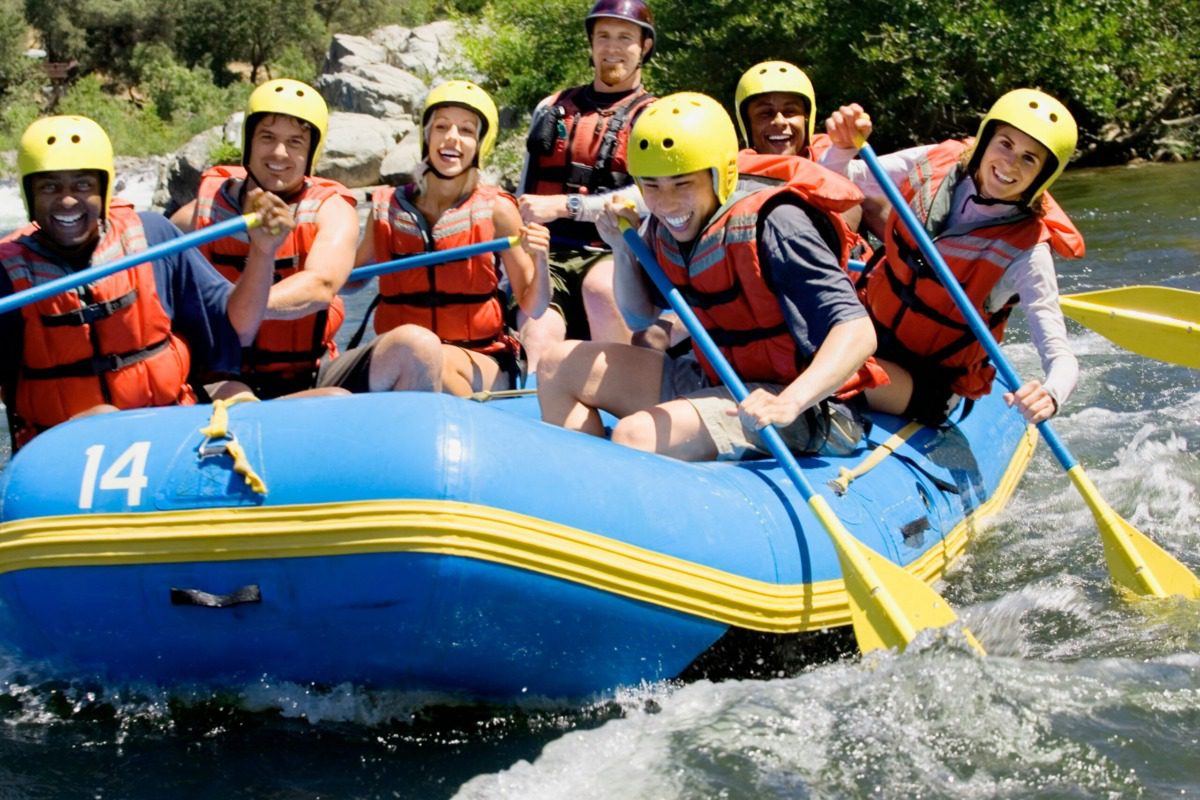
Rafting in North Carolina needs to be on your summer bucket list. (Getty Images/Unsplash)
For nature lovers and adrenaline junkies alike, rafting is this summer’s must-try. Here are the best spots and basics for rafting in North Carolina.
Have you ever experienced the rush of a rapid rocking you downstream? If you haven’t, it’s high time to give it a try. In fact, you may want to add to your 2025 summer bucket list.
Rafting offers adrenaline rushes, adventures on the water, and amazing views. Fortunately for all Tar Heels, this activity is ideal most of the year, particularly from April to October when the weather is warm and water levels are high. Spring and summer are great seasons to get wet on the water for a refreshing way to cool down, while September and October rafting can result in unforgettable views of the iconic fall foliage.
What exactly is rafting, though?
Rafting is a fun, guide-led recreational activity where groups of people navigate rivers on an inflatable raft using paddles. Participants can not only take in views that are only accessible from the river, but can also experience the rush that comes from steering over rapids.
Rapids have different classes that range from I to V. Classes I and II are the most gentle, making these rapids ideal for beginners. Class III, IV, and V rapids are best suited for experienced or expert rafters as these rapids can be rough, unpredictable, and therefore very challenging.
Regardless of your rafting experience, possessing strong swimming skills and wearing a lifejacket are essential. It is also recommended that novice rafters begin their rafting journey with a well-experienced guide.
Note: For the 2025 season, please research before you go to any river, particularly in the western portion of the state, as Hurricane Helene caused damage, left debris, and created safety concerns for many rivers.
The best rivers for rafting in North Carolina

Nantahala River
Located in the Great Smoky Mountains near Bryson City, the Nantahala River is the most popular rafting river for many reasons. Since it is dam-controlled, there is consistent water flow and temperature, ensuring adequate water levels year-round, with temperatures that stay between 48°F and 55°F. It also hosts many rapids, but only in the II-III classes, making it ideal for families and beginners. As if there needs to be more reason to check out Nantahala, its location provides unmatched scenic views of the Smoky Mountains and the Nantahala National Forest.
Where to find a guide: Nantahala Outdoor Center, Fast Rivers Rafting, Endless River Adventures, Whitewater Express, Wildriver rafting, and many more
When to go: May to October
Rapid class: II-III

Green River
Located near Saluda, about an hour south of Asheville, the Green River is another dam-controlled river, ensuring nearly 300 days of whitewater fun. Spring and summer are best for beginners, though, since the weather is warmer and overboard mistakes are more forgiving.
Notably, the river is divided into three sections. The Lower Green River has class I-II rapids, making it beginner-friendly. The Upper Green River has class II-III rapids, but is best for kayakers as group tours aren’t available. The Green River Narrows, for advanced and technically trained rafters only, boasts the highest class rapids and hosts the annual “Green Race” in November. It is also one of the steepest runnable stretches in the U.S., dropping over 600 feet in elevation in a span of just 3 miles.
Surrounded by forest and enchanting businesses in nearby Saluda, rafting here is worth a weekend trip.
Note: portions of the Green River remain closed in the aftermath of Hurricane Helene.
Where to find a guide: Green River Adventures, Green River Cove Tubing (closed for the 2025 season due to Helene), and Wildwater Rafting
When to go: April to August
Rapid class: I-V
Tuckasegee River
Views of lush forestry, picturesque mountains, and wildlife sightings comprise the beauty of the Tuckasegee River, located in Jackson County. Commonly referred to as The Tuck, this river flows through Dillsboro, Sylva, and Whittier over the course of 60 miles.
It’s dam controlled water levels remain consistent throughout the season, though the scheduled releases create class IV rapids that are meant only for viewing or very experienced rafters. Thankfully for those beginning the rafting journey, the rest of the time, rapids here are typically class I-II. That, combined with the 70℉ temperature of the water, makes The Tuck raftable for beginners and families. You can also kayak, paddleboard, and fish here.
Where to find a guide: Tuckaseegee Outfitters, Smoky Mountain River Adventures, and Dillsboro River Company
When to go: May to October
Rapid class: I-III
French Broad River
One of the oldest rivers in North America, the French Broad offers a mix of Class I through IV rapids surrounded by the Pisgah National Forest. The stretch between Asheville and Hot Springs is particularly popular for rafting due to rapids, season, convenience, and beauty.
This stretch of the river is known as section 9, or FB9, and runs pretty much year-round, despite the fact that French Broad is a free-flowing river and not controlled by anything other than Mother Nature. There are lower sections with class I and II rapids, boasting some spots calm enough for a swim. So beginner and intermediate rafters alike can both say “oui” to navigating the French Broad.
Note: Section 9 has been seriously impacted by Helene. Please research before going.
Where to find a guide: French Broad Adventures, Blue Heron Whitewater, Nantahala Outdoor Center (NOC)
When to go: Spring and summer
Rapid class: I-IV

Watatuga River
The Watatuga River has predictable water flow thanks to the Wilbur Dam, making it a reliable river for rafting. Winding through mountain valleys and forests, the river offers beautiful Appalachian scenery, rolling farmland, and occasional wildlife like herons, otters, and deer.
A typical rafting trip along this scenic wonder includes gentle class II and III rapids, splashing waves, and a few slightly technical spots for added adrenaline. Due to the flora and fauna, this is an excellent river for pairing rafting with hiking and a picnic.
Where to find a guide: Wahoos Adventures, High Mountain Expeditions, River & Earth Adventures
When to go: May to September
Rapid class: II-III
Anywhere Else?
If you are an experienced rafter, be sure to also look into the Nolichucky River and the Cheoah River, where rapids are higher class, requiring more skill and adrenaline.
Planning a trip
Whether you are a beginner or a pro, it is helpful to follow a basic set of guidelines when planning a rafting trip. First, book your guide ahead of time. Next, prepare your basic packing list and make sure you are taking adequate safety measures when experiencing the rush of river rafting. Finally, have the most fun.
Basic packing list
- Quick-drying, moisture-wicking clothing like neoprene or synthetics (cotton can retain water and make you chilly)
- Secure footwear, such as water shoes or sandals with straps
- Sunglasses with a strap
- Sunscreen and a hat
- Dry bag with extra clothing (or leave this change of clothing at the hotel or with your ride)
- A cell phone with a waterproof case (a ziplock can work in a pinch)
- First aid supplies
- Lifejacket and helmet
- Bug repellant
- Enough food and water for the trip
Safety
Regardless of your expertise, there are a few safety precautions everyone should take before hitting the rapids.
1) Due diligence: Regardless of any natural disaster, be sure to research water levels, temperatures, and safety concerns before heading toward your river of choice.
2) Join a group: If you are not well-versed in a particular river, join a group with a guide to learn the ins and outs. This will ensure that you are as safe and prepared as possible while learning.
3) Wear the gear: Wearing a lifejacket may feel uncool, especially to strong swimmers, but this device is critical. Rapids are often unpredictable, and there is always a chance for an overboard mishap. A lifejacket could mean leaving the river alive.
4) Share your plans: Like when you are solo traveling or going on a date with a stranger, it is important to tell at least one or two loved ones your exact plans. Share with them the itinerary of where you’ll be starting out, the name of the outfit that is guiding you, where the tour ends, and where you plan to stay. Give a timeline of when they should hear from or see you after the excursion, and then plan a quick call. It helps to have someone concerned and accountable for your safe return.
5) Transportation: Don’t forget to set up a ride for when you get off the water. Rafting trips are only one-way, due to water flow. The person who drove you in is hopefully willing to pick you up. If you cannot secure a ride, research bus schedules, shuttles, and taxis.
Final tips
Check the rivers’ safety levels, particularly for the 2025 season, and make sure you treat yourself to a nice meal and stay for the days you’re fixin’ to raft.
If rafting doesn’t quite fit your idea of fun, try out a local vacation spot or explore one of the recently reopened riverfront parks. With mild temperatures and the laid-back vibes filling the air, summer is a time to get out and explore, in whatever capacity suits your style.

The 7 biggest waterparks in North Carolina, ranked
Are you ready for a carefree day under the summer sun? Check out these big waterparks in North Carolina, which we’ve ranked from worst to best. It’s...

Phenomenal Fourth of July fireworks shows in North Carolina
Check out these magnificent Fourth of July fireworks shows in North Carolina over mountains, cityscapes, or the sea. Apple pie and vanilla ice...

Get ready for summertime fun with this line-up of Asheville and western North Carolina festivals
From music to food to arts and crafts, here is a list of festivals to include in your summertime fun in Asheville and western North Carolina. School...

8 western North Carolina spots to keep cool without breaking the bank
Western North Carolina is loaded with natural waterways, waterfalls and budget recreational activities for families that are looking to beat the...







